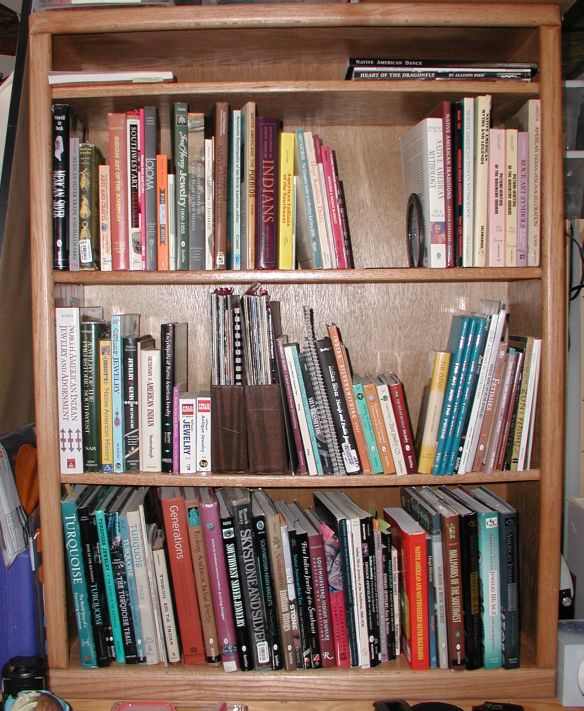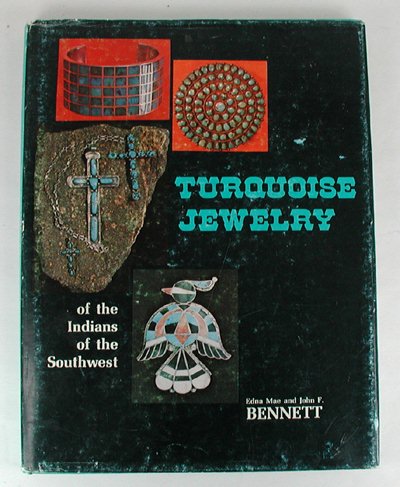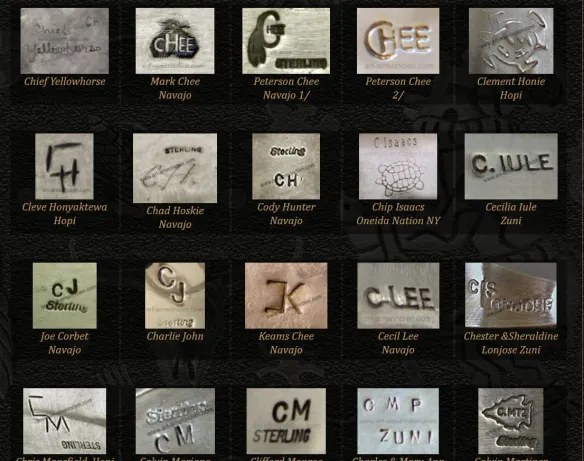There are many good reference books on Native American topics that prove valuable when researching items in the estate lots that come into our store. Starting with a handful of essential hallmark books, our reference library has grown !
Below my signature at the end of this post is a list of many (but not all) of the books in our reference library.
Some we reach for every day, others only when a unique question comes up.
I’ve organized the books in my list by categories so that I can find them easier when I need them – that’s what the headings and abbreviations refer to.
As usual, comments are welcome. If you post in the comment section at the end of this article, other readers will be able to see what you have to say. Let us know if you have read any of these books – which are your favorites, which might have misinformation, which ones are trusted.
I am continually on the lookout for books to add to the reference library and that results in me (more often than I’d like to admit) purchasing the same book twice! Have you ever done that? That’s the main reason I made up this book list – so I can see at a glance what is in the library.
Once a year I go through the entire library to find the duplicates. Click on the book below to go to the page of extra books we have for sale right now.
Paula
HORSEKEEPING LLC – NATIVE AMERICAN REFERENCE BOOK LIST
ARTS AND CRAFTS
AC Guide to American Folk Art of the Southwest – Lamb
AC Native North American Art – Berlo
AC Navajo Arts and Crafts – Schiffer
AC North American Indian Artifacts – Hothem
AC Southwest Art Defined – Booker
FETISH
F Guide to Zuni Fetishes and Carvings – Lamb
F Guide to Zuni Fetishes and Carvings Vol 2 – McManis
F Native American Fetishes – Whittle
F Spirit in the Stone – Bahti
F Zuni Fetish Carvers McManis
F Zuni Fetish Carvers of the 1970s McManis
F Zuni Fetish Carvings Finkelstein
F Zuni Fetishes 1966 – Cushing
F Zuni Fetishes 1999 – Cushing
F Zuni Fetishes and Carvings First Edition 2004 – McManis
F Zuni Fetishes and Carvings Second Edition 2010 – McManis
F Zuni Fetishes– Bennett
F Zuni Fetishism – Kirk
FRED HARVEY
FH Fred Harvey – Armstrong
FH Fred Harvey Jewelry – June
FH Inventing the Southwest Fred Harvey Company – Howard
FH Native American Curio Trade in NM Battin
HALLMARKS
HM American Indian Jewelry I II and III Schaaf
HM Hallmarks of the Southwest – Wright
HM Hopi Silver – Wright
HM Little Book of Marks on Southwestern Silver – Hougart
HM Native American and Southwestern Silver Hallmarks – Hougart
HM Reassessing Hallmarks of Native Southwest Jewelry – Messier
HOPI
H Book of the Hopi – Waters
H Hopi Following the Path of Peace
H Loloma
H Spider Woman Stories – Mullett
H Truth of a Hopi – Nequatewa
KACHINA
K Hopi Kachina Dolls – Colton
K Hopi Kachinas – Wright
MEXICAN
M Mexican Jewelry – Davis and Peck
M Mexican Silver & Hallmarks – Hougart
M Mexican Silver – Morrul and Berk
NATIVE AMERICAN JEWELRY
NAJ Beesh Ligaii in Balance The Besser Collection – Torres-Nez
NAJ Collecting Southwest Native American Jewelry – Bahti
NAJ Evolving Southwest Indian Jewelry – Schiffer
NAJ Fine Indian Jewelry of the Southwest Millicent Rogers Museum Collection – Tisdale
NAJ Generations The Helen Cox Kersting Collection – Nottage
NAJ Guide to Indian Jewelry of the Southwest – Simpson
NAJ How to Invest in Indian Jewelry – Gillespie
NAJ Indian Jewelry Fact and Fantasy – Lund
NAJ Indian Jewelry of the American Southwest – Turnbaugh
NAJ Indian Jewelry on the Market – Schiffer
NAJ Indian Silver Jewelry of the Southwest 1968-1930 – Frank
NAJ Jewelry by Southwest American Indians – Schiffer
NAJ Masterworks and Eccentricities The Druckman Collection – Bauver
NAJ Native American Art 2018 Magazine
NAJ Native American Bolo Ties – Pardue
NAJ Navajo Jewelry A Legacy of Silver and Stone – Jacka
NAJ Navajo Silversmith Fred Peshlakai: His Life & Art
NAJ Silver and Stone – Bahti
NAJ Skystone and Silver – Rosnek
NAJ Southwest Indian Silver from the Doneghy Collection – Lincoln
NAJ Southwest Silver Jewelry – Baxter
NAJ Southwestern Indian Bracelets – Baxter
NAJ Southwestern Indian Jewelry 1992 – Cirillo
NAJ Southwestern Indian Jewelry 2008 – Cirillo
NAJ Southwestern Indian Rings – Baxter
NAJ What You Should Know about Authentic Indian Jewelry – Conroy
NAVAJO
NAV Navajo English Dictionary – Morgan
NAV Navajo Indian Myths – O’Bryan
NAV Navajo Taboos – Bulow
NAV Navajo Walking in Beauty
NAV The book of the Navajo – Locke
NAV The Navaho – Kluckhohn and Leighton
NAV The Navaho – Watkins
PLAINS
PL American Buffalo – Rinella
PL Black Elk & Flaming Rainbow – Neihardt
PL Fools Crow – Mails
PL Healing Power of Horses – Lessons from the Lakota – Baker
PL Indians of the Plains – Lowie
PL Keep Going – Marshall III
PL Lakota Belief and Ritual – Walker
PL Lakota Seeking the Great Spirit
PL Lame Deer Seeker of Visions – Lame Deer and Erdoes
PL Madonna Swan – St. Pierre
PL Offering Smoke – Paper
PL Red Horse Owner’s Winter Count – Karol
PL Stories of the Sioux – Standing Bear
PL The Journey of Crazy Horse – Marshall III
PL The Sacred Pipe Black Elk – Brown
RUGS
R Guide to Navajo Rugs – Lamb
R Guide to Navajo Weaving – McManis
R Navajo Weavings – McManis
R Weaving a Navajo Blanket – Reichard
REFERENCE
REF Antique Jewelry Warman
REF Dictionary of the American Indian
REF Encyclopedia of Native American Jewelry – Baxter
REF Field Guide to Southwest Indian Arts and Crafts – Page
REF Idiots Guide to NA History
REF Indian Jewelry of the Prehistoric Southwest – Jacka and Hammack
REF Jewelry and Gem Buying Guide Matlins
REF Jewelry of the Prehistoric Southwest – Jernigan
REF Jewelry Warman
REF Native American History – Nies
REF North American Indian Jewelry and Adornment – Dubin
REF Rocks, Gems and Mineral
REF The Earth Shall Weep – Wilson
REF Warman’s Jewelry Price Guide
SILVER
S Indian Jewelry Making Vol 1 and 2 – Branson
S Indian Silver – Navajo and Pueblo Jewelry – Bedinger
S Indian Silver Vol 2 – King
S Indian Silversmithing – Hunt
S Indian Silverwork of the Southwest, Illustrated Volume One and 2 booklets – Mera
S Navajo and Pueblo Silversmiths – Adair
S Navajo Silver – Hegemann
S Navajo Silver , a brief history of Navajo Silversmithing– Woodward
SYMBOLS
SYM American Indian Design and Decoration – Appleton
SYM Field Guide to Rock Art Symbols Patterson
SYM Heart of the Dragonfly Birt
SYM Picture Writing of the American Indians 1 & 2
TURQUOISE
T Arizona Highways Turquoise Blue Book
T Jewel of the Southwest – Turquoise – Osburn
T Turquois Pogue
T Turquoise and the Indian – Bennett
T Turquoise Jewelry – Schiffer
T Turquoise Jewelry of the Indians of the Southwest – Bennett
T Turquoise Mines Mineral and Wearable Art – Block
T Turquoise The Gem of the Century – Branson
T Turquoise The World Story of a Fascinating Gemstone – Lowry
T Turquoise Trail – Karasik
T Turquoise Unearthed – Lowry
TRADITIONS, MYTHS, and RELIGION
T&M American Indain Ceremonies
T&M American Indian Stories – Zitkala-Sa
T&M Animal Speak – Andrews
T&M Encyclopedia of Native American Healing – Lyon
T&M Hisoric Books Detailing Native American Indian Religions – DVD
T&M Indian Legends – Clark
T&M Native American Dance
T&M Native American Mythology Gill & Sullivan
T&M Native American Myths and Legends Taylor
T&M Native American Traditions – Versluis
T&M North American Indian Mythology Burland
T&M Southwestern Indian Ceremonials
T&M The Sons of the Wind – Dooling
T&M The Spirit of Indian Women – Fitzgerald
T&M The Voices of the Winds – Edmonds and Clark
T&M The Wind is My Mother – Bear Heart
T&M The Wisdom of the Native Americans – Nerburn
TRIBES
TR America’s Indian Background – Walker
TR American Indians of the Southwest Dutton
TR Enclyclopedia of Native American Tribes – Waldman
TR Encyclopedia of Native American Indians – Hoxie
TR Encyclopedia of North American Indians – Ciment
TR Native American The Pueblos Erdoes
TR The North American Indian Images – Curtis DVD
TR The Story of the Cherokee People – Underwood
ZUNI
Z Figural Designs in Zuni Jewelry – Sei
Z Hopi Bird and Sunface in Zuni Jewelry – Sei
Z Kachinas and Ceremonial Dancers in Zuni Jewelry – Sei
Z Knifewing and Rainbow Man in Zuni Jewelry – Sei
Z Whos Who in Zuni Jewelry –
Z Zuni Jewelry – 3rd edition – Bassman
Z Zuni, A Village of Silversmiths – Ostler
Z Zuni, the Art and the People, Vol 1, 2 3 – Bell
Z Zunis, The by Zunis
MORE BOOKS SUGGESTED BY READERS……..
Ray Manley’s Portraits and Turquoise of Southwest Indians” with text by Clara Lee Tanner.
























